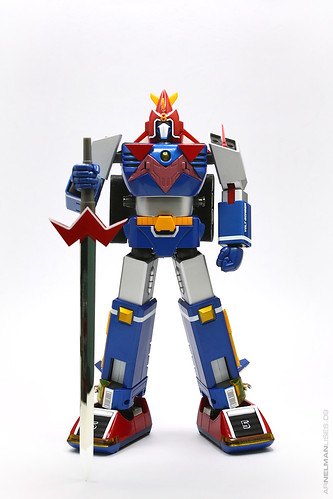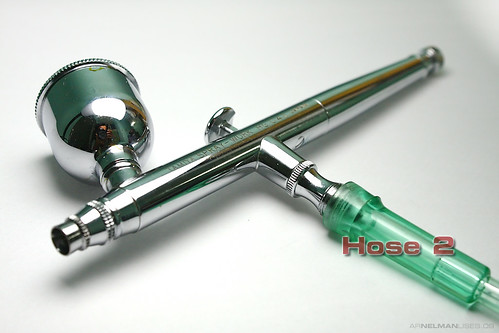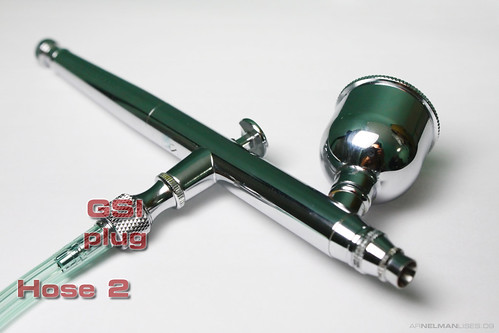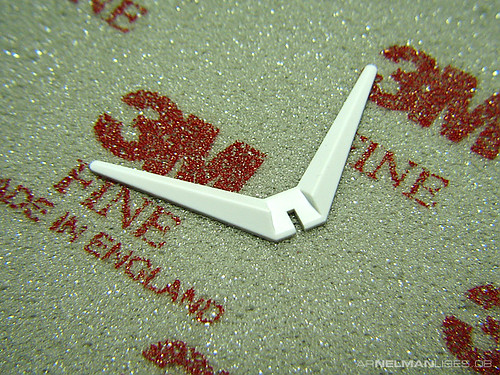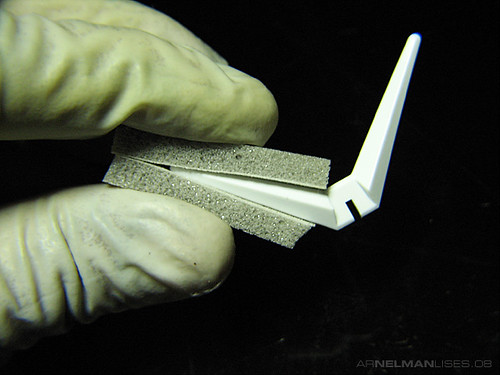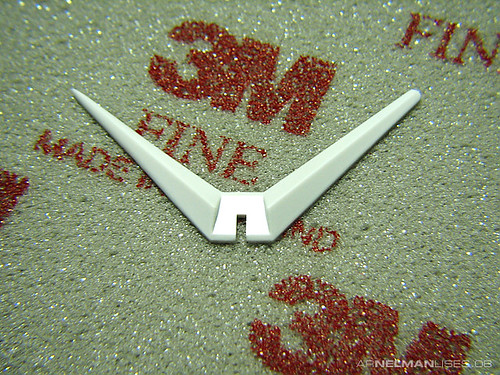Here's another lighting setup that I use if I'm not that lazy in putting up the lamps when I'm shooting my toys.
This time I'm using a dark background and two 23-watt fluorescent lamps to capture the Volt Bomber's profile.
A black board was utilized as the platform and background, while the two lamps were placed on both sides. The one on the left was placed slightly above the Lander, while the one on the right was level with the toy.
Copy papers were used to diffuse the direct light coming from the lamps. This was necessary to eliminate the harsh lights and to keep the highlights from being blown up.
Finally, since I do not have barn-doors (metal flaps that allow you to prevent the light from a certain area) two more boards were used to block the lights from spilling over to the background*.
You can click on the image of the setup above to view the complete notes.
Oh yeah, the result --
* I know, I should have taken comparison shots to clearly show what the heck I'm talking about when I talk about harsh lights or blown highlights. Promise, I'll do that next time. ^_^
Showing posts with label guides. Show all posts
Showing posts with label guides. Show all posts
Friday, September 04, 2009
Wednesday, September 02, 2009
How to lazily light your figures
Lazily. That's the operative word for this guide.
If you can't afford (or haven't bought) a decent lighting setup yet, then I guess this is also the guide for you.
In other words, this is a cheap solution in setting up your figures for a decent photo.
This is the setup I almost always use when I do not want to bother arranging lamps and other stuff for about 20 minutes just to take an image. Yes, lazy.
Here are the things you'll need:
I'll skip the narratives on how to set this up and just show the pic --
For the complete notes, just click on the image above.
Here's the result --
By the way, secure the lamp and aluminum rods safely to the boxes on the left and the right. I made the mistake of not fastening them at all. As I was adjusting the background for a different angle, the lamp fell and broke into a gazillion pieces. That happened within an hour of taking the photo above. Oh well, great luck!
If you can't afford (or haven't bought) a decent lighting setup yet, then I guess this is also the guide for you.
In other words, this is a cheap solution in setting up your figures for a decent photo.
This is the setup I almost always use when I do not want to bother arranging lamps and other stuff for about 20 minutes just to take an image. Yes, lazy.
Here are the things you'll need:
- A table where you're going to set your lights up. If don't have a free table around, you can use the floor. Just be prepared to lie on your stomach for quite a bit.
- A bristol board or any large sheet of paper (you can use cloth/textile) to use as the base and background of your figure.
- A 32-watt fluorescent lamp.
- A couple of rods.
- A couple of boards or large boxes to serve as light reflectors.
I'll skip the narratives on how to set this up and just show the pic --
For the complete notes, just click on the image above.
Here's the result --
By the way, secure the lamp and aluminum rods safely to the boxes on the left and the right. I made the mistake of not fastening them at all. As I was adjusting the background for a different angle, the lamp fell and broke into a gazillion pieces. That happened within an hour of taking the photo above. Oh well, great luck!
Tuesday, July 21, 2009
Poor man's modeling - Neb kit hose hack: Redux
Remember my Neb kit hose hack post last year (August, 2008), which was part of my Poor Man's Modeling series?
I didn't quite finish it, did I?
Anyway, resting after a sumptuous dinner-date with my fiancee last night wasn't really an option. Too much calories were taken in, and I had to burn some of them. Besides, co-members from a local GunPla forum got a bit interested in my pseudo-compressor of a nebulizer.
Let's get things underway, shall we?
First off, the materials. You need the following lest you decide to make the entire system out of paper mache:
A. A nebulizer kit hose (two of them, actually... I'll explain why you need two in the latter part.) These come relatively cheap from your neighborhood drugstores. You can buy the ones for adults, or the ones for infants. It really doesn't matter. On second thought, get the one for adults. You can use the mask as an alternative when you are doing the dirty deed -- airbrushing... what were you thinking? Anyway, each costs around Php100.00 a pop. If possible, get the hose without inner ridges.
B. GSI Creos' One-Touch Plug for Mr. One-Touch Hose 1/8 S. These plugs aren't really necessary, but if you want your hoses to fit on your airbrush without them popping off from time to time, you might want to consider 'em. By the way, I'm using a Tamiya Spray Work HG airbrush and these plugs are the ones that work with it. If you've got a different AB, go to your favorite hobby store and get the plugs that work with YOUR airbrush. Don't come running back to me, crying, and saying that the plugs won't work. They come in two pieces per pack... I don't know why, but they just do. If you don't need the extra plug, sell it to a geeky friend. Say that it came from the Apollo rocket, or something important. Oh yeah, I got mine for around Php650.00 from STC in V-Mall, Greenhills.
C. Bleeder valves. They are the ones used for aquariums to redirect/lessen the air going into your fishes' domain. You can make the bleeder valves work by turning the small levers. These valves can range from Php50.00 to Php120.00 each. Some has got two bleeder valves, while others can have three or four. They are not really required, but it's nice to have one around just in case you want to decrease the air volume going into your airbrush for detailing work. I don't use them. Really. I just bought one because I thought I needed it. I might someday. I was a boy scout. 'Nuff said.
D. A pair of scissors, or cutters... or blades. Any cutting tool will do. If two slabs of granite can cut cleanly through your neb kit hose, then fine.
E. Silicone or epoxy... some type of sealant. I used silicone for my hose.
Okay, now that we've put the requirements out of the way, it's time to hack that hose.
1. This is basically the nebulizer kit hose with the attachment for holding the nebule -- the nebule tank. Hose 1 is attached normally, while Hose 2 is attached to the part where the face mask is supposed to go. Fix Hose 2 in place by using the silicone... lots of it. In short, be generous with the application of the sealant. Let the sealant dry to bind the the pieces.
2. If you do not have the GSI Creos' One-Touch Plug for Mr. One-Touch Hose 1/8 S, this will be the penultimate step for you. Otherwise, proceed to Step 4.
Attach the other end of Hose 1 to the nebulizer. You might need... I guess the proper phrase would be -- you WILL need to force the end of the hose to your airbrush. It may take a bit of elbow grease, but it will fit. Now, this isn't exactly what you may call a snug one, but it's the only thing you can do without the GSI plugs. I encountered a few times wherein the hose kept on popping out with this setup, so the plugs are a welcome addition.
3. Attach the other end of Hose 2 to your airbrush. Proceed to Step 8.
4. You should have reached this step if you've got the GSI plugs. If not, go back to Step 2. Cut the other end of Hose 2 (the one you didn't seal to the nebule holder) with your granite slabs, er, scissors.
5. Get one of the GSI plugs.
6. Attach it to your airbrush.
7. Attach the end of Hose 2 (which should now be cut) to the GSI plug. If the inner walls of your hose has got ridges, the air coming out of the nebulizer will leak. You can remedy this by tying Twist Ties to clamp the hose tightly to the plug.
8. You're done! But wait... in the case that too much air volume is rushing out of the nebulizer, you can do this final step to bleed some air out. This is one part in the Poor-man's-GunPla series, remember? We do not have enough moolah for air regulators. Cut anywhere along Hose 2. I would suggest to cut near the nebule holder so the length of the hose wouldn't be compromised in case you want to chicken out and not use the bleeder valves anymore. Insert the bleeder valve between the 2 pieces of Hose 2.
NOW you're done! Happy airbrushing!
Notes of further confusion:
1. You really need only one piece of hose to make this work. However, you will notice that as you go about airbrushing kit pieces of your precious PG Strike a bit longer, condensation will appear inside your hose. That's where the nebule holder comes in very handy. It acts as some sort of water trap. It is best if you put a piece (or two) of cotton balls in it (nebule holder) to be sure that water (condensation) will not ride up to your airbrush.
2. The transparent hoses make it easier to see if some sort of condensation (again, water) appears inside your hose.
3. This hack would work with either single-action or double-action airbrushes. However, as you may very well know, the dual-action functionality of, well, dual-action airbrushes, are useless without them being connected to air tanks
Click here to see the rest of the Poor Man's GunPla/Modeling series.
Addition:
If someone else is using the nebulizer (most likely for health treatments like asthma) it would be best if you cover the neb unit when you are airbrushing. This is needed so that stray paint wouldn't stick to the unit and make it look like a graffiti wall.
I didn't quite finish it, did I?
Anyway, resting after a sumptuous dinner-date with my fiancee last night wasn't really an option. Too much calories were taken in, and I had to burn some of them. Besides, co-members from a local GunPla forum got a bit interested in my pseudo-compressor of a nebulizer.
Let's get things underway, shall we?
First off, the materials. You need the following lest you decide to make the entire system out of paper mache:
A. A nebulizer kit hose (two of them, actually... I'll explain why you need two in the latter part.) These come relatively cheap from your neighborhood drugstores. You can buy the ones for adults, or the ones for infants. It really doesn't matter. On second thought, get the one for adults. You can use the mask as an alternative when you are doing the dirty deed -- airbrushing... what were you thinking? Anyway, each costs around Php100.00 a pop. If possible, get the hose without inner ridges.
B. GSI Creos' One-Touch Plug for Mr. One-Touch Hose 1/8 S. These plugs aren't really necessary, but if you want your hoses to fit on your airbrush without them popping off from time to time, you might want to consider 'em. By the way, I'm using a Tamiya Spray Work HG airbrush and these plugs are the ones that work with it. If you've got a different AB, go to your favorite hobby store and get the plugs that work with YOUR airbrush. Don't come running back to me, crying, and saying that the plugs won't work. They come in two pieces per pack... I don't know why, but they just do. If you don't need the extra plug, sell it to a geeky friend. Say that it came from the Apollo rocket, or something important. Oh yeah, I got mine for around Php650.00 from STC in V-Mall, Greenhills.
C. Bleeder valves. They are the ones used for aquariums to redirect/lessen the air going into your fishes' domain. You can make the bleeder valves work by turning the small levers. These valves can range from Php50.00 to Php120.00 each. Some has got two bleeder valves, while others can have three or four. They are not really required, but it's nice to have one around just in case you want to decrease the air volume going into your airbrush for detailing work. I don't use them. Really. I just bought one because I thought I needed it. I might someday. I was a boy scout. 'Nuff said.
D. A pair of scissors, or cutters... or blades. Any cutting tool will do. If two slabs of granite can cut cleanly through your neb kit hose, then fine.
E. Silicone or epoxy... some type of sealant. I used silicone for my hose.
Okay, now that we've put the requirements out of the way, it's time to hack that hose.
1. This is basically the nebulizer kit hose with the attachment for holding the nebule -- the nebule tank. Hose 1 is attached normally, while Hose 2 is attached to the part where the face mask is supposed to go. Fix Hose 2 in place by using the silicone... lots of it. In short, be generous with the application of the sealant. Let the sealant dry to bind the the pieces.
Notice the splatters of paint on the tank? ^_^
2. If you do not have the GSI Creos' One-Touch Plug for Mr. One-Touch Hose 1/8 S, this will be the penultimate step for you. Otherwise, proceed to Step 4.
Attach the other end of Hose 1 to the nebulizer. You might need... I guess the proper phrase would be -- you WILL need to force the end of the hose to your airbrush. It may take a bit of elbow grease, but it will fit. Now, this isn't exactly what you may call a snug one, but it's the only thing you can do without the GSI plugs. I encountered a few times wherein the hose kept on popping out with this setup, so the plugs are a welcome addition.
3. Attach the other end of Hose 2 to your airbrush. Proceed to Step 8.
4. You should have reached this step if you've got the GSI plugs. If not, go back to Step 2. Cut the other end of Hose 2 (the one you didn't seal to the nebule holder) with your granite slabs, er, scissors.
5. Get one of the GSI plugs.
6. Attach it to your airbrush.
The Tamiya Spray Work HG airbrush and a GSI plug
The GSI plug attached to the Tamiya Spray Work HG airbrush
7. Attach the end of Hose 2 (which should now be cut) to the GSI plug. If the inner walls of your hose has got ridges, the air coming out of the nebulizer will leak. You can remedy this by tying Twist Ties to clamp the hose tightly to the plug.
8. You're done! But wait... in the case that too much air volume is rushing out of the nebulizer, you can do this final step to bleed some air out. This is one part in the Poor-man's-GunPla series, remember? We do not have enough moolah for air regulators. Cut anywhere along Hose 2. I would suggest to cut near the nebule holder so the length of the hose wouldn't be compromised in case you want to chicken out and not use the bleeder valves anymore. Insert the bleeder valve between the 2 pieces of Hose 2.
The bleeder valve installed
NOW you're done! Happy airbrushing!
Notes of further confusion:
1. You really need only one piece of hose to make this work. However, you will notice that as you go about airbrushing kit pieces of your precious PG Strike a bit longer, condensation will appear inside your hose. That's where the nebule holder comes in very handy. It acts as some sort of water trap. It is best if you put a piece (or two) of cotton balls in it (nebule holder) to be sure that water (condensation) will not ride up to your airbrush.
2. The transparent hoses make it easier to see if some sort of condensation (again, water) appears inside your hose.
3. This hack would work with either single-action or double-action airbrushes. However, as you may very well know, the dual-action functionality of, well, dual-action airbrushes, are useless without them being connected to air tanks
Click here to see the rest of the Poor Man's GunPla/Modeling series.
Addition:
If someone else is using the nebulizer (most likely for health treatments like asthma) it would be best if you cover the neb unit when you are airbrushing. This is needed so that stray paint wouldn't stick to the unit and make it look like a graffiti wall.
Tuesday, November 18, 2008
DIY series: Gundam v-fin sharpening
Here's how I do it... v-fin sharpening -- the down and dirty way.
I used this process for the horn on my Unicorn Gundam, however, I wasn't able to put up an entry on how I did it.

 My Unicorn Gundam, prior to sharpening its horn. Notice how un-Unicorn it looks like with the horn not sharpened? Ugh!
My Unicorn Gundam, prior to sharpening its horn. Notice how un-Unicorn it looks like with the horn not sharpened? Ugh!
Here's the RX-0 with its horn sharpened --
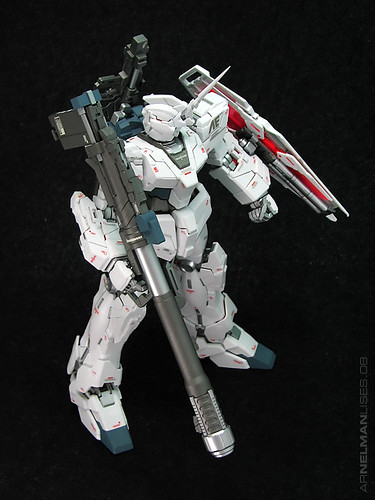
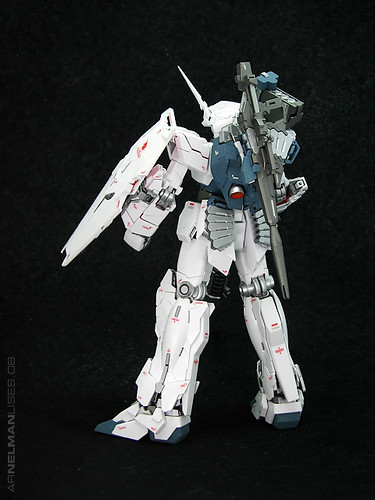 There... I think that's a bit better, right?
There... I think that's a bit better, right?
Ok, here's what you need --
1. A sanding sponge. I used 3M's fine-grit sanding sponge for the purpose.
2. The v-fin, of course! For this sample, I used my SD RX-78-2's v-fin.
Cut two small pieces off the sponge and sandwich the v-fin between them. Sand away by moving the v-fin in and out of the "sponge sandwich". Yup, in and out, push and pull.
Be careful, though, as things can easily get out of hand while you're sanding the v-fin. You might wanna stop halfway through the sharpening process and use some finesse to fine-tune the shape of the fin and its tip. Slowly, but surely, does the trick.
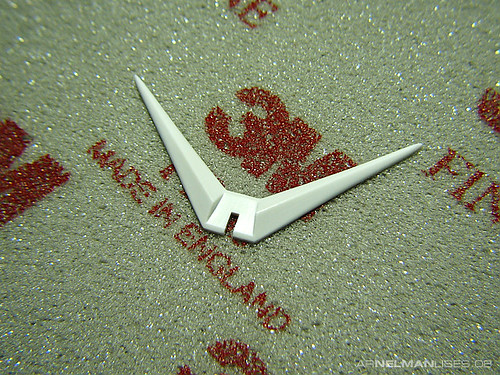
Here's the final outcome, with both fins sharpened. As you may notice, I'm not quite finished with the right fin yet... I was too excited to take a pic! ^_^
There you have it, the down and dirty way of sharpening your Gundam's v-fin.
I used this process for the horn on my Unicorn Gundam, however, I wasn't able to put up an entry on how I did it.

 My Unicorn Gundam, prior to sharpening its horn. Notice how un-Unicorn it looks like with the horn not sharpened? Ugh!
My Unicorn Gundam, prior to sharpening its horn. Notice how un-Unicorn it looks like with the horn not sharpened? Ugh!Here's the RX-0 with its horn sharpened --

 There... I think that's a bit better, right?
There... I think that's a bit better, right?Ok, here's what you need --
1. A sanding sponge. I used 3M's fine-grit sanding sponge for the purpose.
2. The v-fin, of course! For this sample, I used my SD RX-78-2's v-fin.
Cut two small pieces off the sponge and sandwich the v-fin between them. Sand away by moving the v-fin in and out of the "sponge sandwich". Yup, in and out, push and pull.
Be careful, though, as things can easily get out of hand while you're sanding the v-fin. You might wanna stop halfway through the sharpening process and use some finesse to fine-tune the shape of the fin and its tip. Slowly, but surely, does the trick.

Here's the final outcome, with both fins sharpened. As you may notice, I'm not quite finished with the right fin yet... I was too excited to take a pic! ^_^
There you have it, the down and dirty way of sharpening your Gundam's v-fin.
Saturday, September 13, 2008
Poor man's Gunpla - Scribing panel lines
Something new comes up every single day... and now, I'm blogging even on weekends. I'm starting to like this blog thingie. It also helps if you've got a beer in hand and Doritos on the other... which I'm sharing with my pet Shih Tzu -- Sassy.
As I've said, something new comes up everyday. This afternoon, I tried my hand at scribing panel lines on my current work-in-progress, the MG Strike Rouge. I only have the faintest idea on how to go about the process. All I know is one needs a line scriber (which I don't have), thick adhesive tapes as guides (which I don't have), and some patience (oooh, I have lotsa those!) May the Gunpla gods have mercy on me on my first try.
I've got in my hand my first can of beer. San Miguel Beer Pale Pilsen to be exact.
I want my MG Strike Rouge to be a bit different from the other Strike Rouges that have been built. If you've been following my previous posts for some time, you would know by now why that is the case... and I would never tire of saying it -- Cagalli's MS is my favorite.
I am quite a brave chap... or probably a stupid one at that. I didn't practice scribing on trees/sprues/runners or spare parts... I'd have none of that. Instead, I went ahead and did it on my Rouge. If something goes wrong, there's always Tamiya putty. ^_^
On to the task at hand. First of all, I needed a plastic line scriber (which I don't have) for scribing the part -- a piece of armour on the Rouge's forearm. I used my X-acto knife for this purpose. I replaced the #11 blade with a spanking new one. My lack of a line scriber and the use of my X-acto knife makes it official -- this post should be a part of my "Poor man's Gunpla" collection.
Now I needed a thick adhesive tape. You know, those Dymo self-adhesive labeling tapes? The ones where you can emboss your name onto? Yes, the thick ones... and yes, I don't have 'em too... I just used Tamiya masking tapes today... although I will get those Dymo tapes soon.
I didn't have a hard time imagining the design of the extra panel lines. I looked into the perfect grade version of the Strike/Strike Rouge for inspiration. I've always adored the design of the PG Strikes, so that's where I started.
Step 1: Nothing special on the following image, I just used a pencil to outline the panel line I am going to scribe.
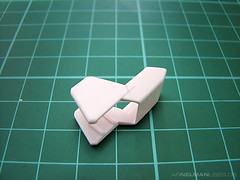
Step 2: I used Tamiya's masking tape as guides for the blades of my X-acto knife. Gingerly scribe lines on to the part using the back of the knife. There's no need to rush things now. It is better to run the blade tens of times over that part rather than use brute force. You're not trying gut the part you know. Think of yourself as a graceful, well, grave digger. ^_^ You need not remove 6 feet of earth all in one digging, right?

After scribing the guide lines, you can remove the tapes and proceed to deepen the panel lines. The tapes would just be a hindrance once you are in the stage of deepening the lines. If you find yourself making wayward lines, don't worry, we'll take care of that later.
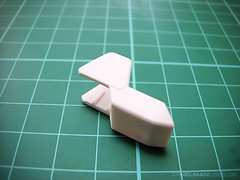
Step 3: After digging the grave, err, scribing the line. Use a grit-800 sandpaper to clean up the new panel line and to remove the wayward strokes of your knife. In my case, I used 3M's Ultrafine sanding sponge for the job. Here's how it looked like after the clean-up. Not bad eh?
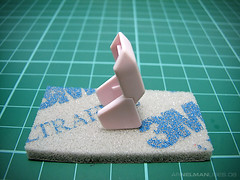
I'm now on my third can of beer... damn, I'm too slow tonight!
For a little comparison, the scribed part is on the left while the unscribed one is on the right.
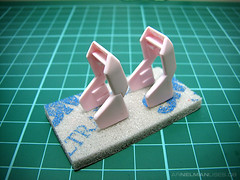
For good measure and an attempt to be faithful to the Evolve design (even though in panel lines only), I added more panel lines to the armour.

That's it! I survived my first try at scribing panel lines! Now you know why I'm drinking! ^_^
The only downside to this is that it takes up sooooo much time! I think it took me a couple of hours (pardon the newbie, please) to scribe that piece of armour.
I'm now on my fourth beer and it's time to wrap up this thing.
It's gonna be a long road ahead for me and my Rouge... and we'll be there at the end.
As I've said, something new comes up everyday. This afternoon, I tried my hand at scribing panel lines on my current work-in-progress, the MG Strike Rouge. I only have the faintest idea on how to go about the process. All I know is one needs a line scriber (which I don't have), thick adhesive tapes as guides (which I don't have), and some patience (oooh, I have lotsa those!) May the Gunpla gods have mercy on me on my first try.
I've got in my hand my first can of beer. San Miguel Beer Pale Pilsen to be exact.
I want my MG Strike Rouge to be a bit different from the other Strike Rouges that have been built. If you've been following my previous posts for some time, you would know by now why that is the case... and I would never tire of saying it -- Cagalli's MS is my favorite.
I am quite a brave chap... or probably a stupid one at that. I didn't practice scribing on trees/sprues/runners or spare parts... I'd have none of that. Instead, I went ahead and did it on my Rouge. If something goes wrong, there's always Tamiya putty. ^_^
On to the task at hand. First of all, I needed a plastic line scriber (which I don't have) for scribing the part -- a piece of armour on the Rouge's forearm. I used my X-acto knife for this purpose. I replaced the #11 blade with a spanking new one. My lack of a line scriber and the use of my X-acto knife makes it official -- this post should be a part of my "Poor man's Gunpla" collection.
Now I needed a thick adhesive tape. You know, those Dymo self-adhesive labeling tapes? The ones where you can emboss your name onto? Yes, the thick ones... and yes, I don't have 'em too... I just used Tamiya masking tapes today... although I will get those Dymo tapes soon.
I didn't have a hard time imagining the design of the extra panel lines. I looked into the perfect grade version of the Strike/Strike Rouge for inspiration. I've always adored the design of the PG Strikes, so that's where I started.
Step 1: Nothing special on the following image, I just used a pencil to outline the panel line I am going to scribe.

Step 2: I used Tamiya's masking tape as guides for the blades of my X-acto knife. Gingerly scribe lines on to the part using the back of the knife. There's no need to rush things now. It is better to run the blade tens of times over that part rather than use brute force. You're not trying gut the part you know. Think of yourself as a graceful, well, grave digger. ^_^ You need not remove 6 feet of earth all in one digging, right?

After scribing the guide lines, you can remove the tapes and proceed to deepen the panel lines. The tapes would just be a hindrance once you are in the stage of deepening the lines. If you find yourself making wayward lines, don't worry, we'll take care of that later.

Step 3: After digging the grave, err, scribing the line. Use a grit-800 sandpaper to clean up the new panel line and to remove the wayward strokes of your knife. In my case, I used 3M's Ultrafine sanding sponge for the job. Here's how it looked like after the clean-up. Not bad eh?

I'm now on my third can of beer... damn, I'm too slow tonight!
For a little comparison, the scribed part is on the left while the unscribed one is on the right.

For good measure and an attempt to be faithful to the Evolve design (even though in panel lines only), I added more panel lines to the armour.

That's it! I survived my first try at scribing panel lines! Now you know why I'm drinking! ^_^
The only downside to this is that it takes up sooooo much time! I think it took me a couple of hours (pardon the newbie, please) to scribe that piece of armour.
I'm now on my fourth beer and it's time to wrap up this thing.
It's gonna be a long road ahead for me and my Rouge... and we'll be there at the end.
Tuesday, August 05, 2008
Poor man's modeling - Neb kit hose hack
So you want to buy an airbrush but don't have enough moolah (yet) to buy a hobby compressor and all you've got around the house is a nebulizer... well, here's a hack you might want to consider.
Things you need:
A. Nebulizer kit
B. GSI Creos' One-Touch Plug for Mr. One-Touch Hose 1/8 S
C. Scissors (or your hobby knife)
D. Airbrush (this hack is useless without it)

I strongly suggest that you do not hack the original kit that came with the nebulizer.
1. Get a nebulizer kit from a nearby pharmacy/drugstore. It doesn't matter if you get the one for kids or for adults... all you need (for now) is the hose. Another important thing to consider is try to purchase the kit without ridges/channels on the inner wall of the hose.
2. Get a scissor and cut away the hose's adapter. Be careful. You wouldn't enjoy this hack a few minutes later if you've got a lacerated finger.
3. Get one of the two One-touch plugs from its packaging. These plugs come in two. Why two? Well it allows you to quickly switch between two airbrushes without ever removing either plug. It retails at around US$9.24. These plugs will fit Tamiya HG and Badger airbrushes. But please don't take my word for it... yet. Go to your local hobby shop and bring your airbush with you in order to verify that it does indeed fit.
4. Insert the One-touch plug at the end of the hose you've just cut. Connect the plug to your airbrush and connect the other end of the hose to the nebulizer.
Kudos! That's all there is to it!
BTW, nebulizers blow more air (around 20 liters-per-minute) than your hobby-grade compressors, which let air out at around 15psi. Helpful math-wizards out there reading this, kindly help me out and send me the computation from liters-per-minute of air to PSI (if there's such a thing).
For this reason you might want to buy a bleeder valve, which is available at pet stores. They are used for aquarium air supply hoses.
More on the bleeder valve hack in the future.
Note for purists: Hobby-grade compressors are still the best when it comes to airbrushing. Once you save up for one, get it.
Happy airbrushing!
Things you need:
A. Nebulizer kit
B. GSI Creos' One-Touch Plug for Mr. One-Touch Hose 1/8 S
C. Scissors (or your hobby knife)
D. Airbrush (this hack is useless without it)

I strongly suggest that you do not hack the original kit that came with the nebulizer.
1. Get a nebulizer kit from a nearby pharmacy/drugstore. It doesn't matter if you get the one for kids or for adults... all you need (for now) is the hose. Another important thing to consider is try to purchase the kit without ridges/channels on the inner wall of the hose.
2. Get a scissor and cut away the hose's adapter. Be careful. You wouldn't enjoy this hack a few minutes later if you've got a lacerated finger.
3. Get one of the two One-touch plugs from its packaging. These plugs come in two. Why two? Well it allows you to quickly switch between two airbrushes without ever removing either plug. It retails at around US$9.24. These plugs will fit Tamiya HG and Badger airbrushes. But please don't take my word for it... yet. Go to your local hobby shop and bring your airbush with you in order to verify that it does indeed fit.
4. Insert the One-touch plug at the end of the hose you've just cut. Connect the plug to your airbrush and connect the other end of the hose to the nebulizer.
Kudos! That's all there is to it!
BTW, nebulizers blow more air (around 20 liters-per-minute) than your hobby-grade compressors, which let air out at around 15psi. Helpful math-wizards out there reading this, kindly help me out and send me the computation from liters-per-minute of air to PSI (if there's such a thing).
For this reason you might want to buy a bleeder valve, which is available at pet stores. They are used for aquarium air supply hoses.
More on the bleeder valve hack in the future.
Note for purists: Hobby-grade compressors are still the best when it comes to airbrushing. Once you save up for one, get it.
Happy airbrushing!
Wednesday, May 14, 2008
Infinite Justice Gundam Colors
Ok. I was on the prowl for color translations about the SD Justice Gundam while browsing today. It would sure make a pleasant surprise to my fiancee if I could present to her a painted BB #268 and not just some snap-built wuss. After all, she hand-picked the SD Justice while I was busy inspecting MGs at one of the hobby shops that we frequent during weekends.
Sadly, one of the local Gunpla forums only had color translations for MG kits. As you may know already, the Infinite Justice (nor the Justice) hasn't been rewarded by Bandai with an MG variant... yet. C'mon Bandai!
Anyway, Google kept pointing me to Hobby Search Japan's color reference scan of the 1/100 ∞ Justice manual. Yay. I know much about the mating habits of a Tse-tse fly as I do about reading Kanji.
The genius (or lack of it) in me thought -- "Converting this Justice color guide can't be too hard, all I gotta do is compare!"
After getting a Gunze Sangyo color chart translation, I began comparing the color reference scan's images to the color charts... yadda... yadda... yadda.
Was I successful? I wouldn't be writing about the experience if I wasn't, would I? It was quite fun, actually. So much, fun that I might do other color translations. Now, I know some Kanji... or at least the symbols for the primary colors. LOL!
'Nuff said. Here it is, the translation of the ∞ Justice Gundam for all of us non-Kanji-reading Gunpla lovers out there:
Column 1:
White (40%) + Pink (30%) + Yellow (20%) + Purple (10%)
Yellow (90%) + Orange Yellow (10%)
White (100%)
Red (40%) + Pink (30%) + Purple (30%)
Yellow Green (100%)
Column 2:
Black (60%) + Navy Blue (40%)
White (50%) + Silver (50%)
Neutral Gray (90%) + Black (10%)
Intermediate Blue (40%) + Neutral Gray (30%) + White (20%)
Sky Blue (50%) + White (50%)
The colors were based on Gunze Sangyo products. Tamiya's got most of the colors above, so I don't think that you would have a hard time if you're a Tamiya-lover (like me!)
Don't ask me about what the topcoats are for this translation. In case you haven't read my previous paragraphs, I know crap about Kanji.
By the way, please take my translation with a grain of salt. All I did was compare the symbols. My conversion can be likened to a toddler who's being asked to compare shapes! LOL! So if you've notice errors in my translation above, please do feel free to inform me... kindly.
Sadly, one of the local Gunpla forums only had color translations for MG kits. As you may know already, the Infinite Justice (nor the Justice) hasn't been rewarded by Bandai with an MG variant... yet. C'mon Bandai!
Anyway, Google kept pointing me to Hobby Search Japan's color reference scan of the 1/100 ∞ Justice manual. Yay. I know much about the mating habits of a Tse-tse fly as I do about reading Kanji.
The genius (or lack of it) in me thought -- "Converting this Justice color guide can't be too hard, all I gotta do is compare!"
After getting a Gunze Sangyo color chart translation, I began comparing the color reference scan's images to the color charts... yadda... yadda... yadda.
Was I successful? I wouldn't be writing about the experience if I wasn't, would I? It was quite fun, actually. So much, fun that I might do other color translations. Now, I know some Kanji... or at least the symbols for the primary colors. LOL!
'Nuff said. Here it is, the translation of the ∞ Justice Gundam for all of us non-Kanji-reading Gunpla lovers out there:
Column 1:
White (40%) + Pink (30%) + Yellow (20%) + Purple (10%)
Yellow (90%) + Orange Yellow (10%)
White (100%)
Red (40%) + Pink (30%) + Purple (30%)
Yellow Green (100%)
Column 2:
Black (60%) + Navy Blue (40%)
White (50%) + Silver (50%)
Neutral Gray (90%) + Black (10%)
Intermediate Blue (40%) + Neutral Gray (30%) + White (20%)
Sky Blue (50%) + White (50%)
The colors were based on Gunze Sangyo products. Tamiya's got most of the colors above, so I don't think that you would have a hard time if you're a Tamiya-lover (like me!)
Don't ask me about what the topcoats are for this translation. In case you haven't read my previous paragraphs, I know crap about Kanji.
By the way, please take my translation with a grain of salt. All I did was compare the symbols. My conversion can be likened to a toddler who's being asked to compare shapes! LOL! So if you've notice errors in my translation above, please do feel free to inform me... kindly.
Subscribe to:
Posts (Atom)




